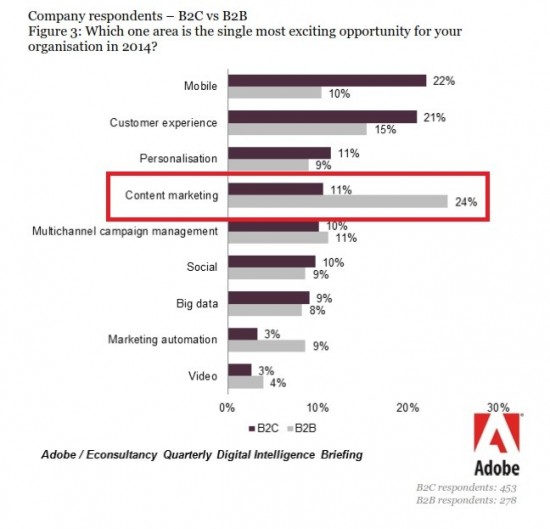Content creation is top of mind for B2B marketers because without content your sales funnel is dead in the water. According to a recent report from Econsultancy and Adobe, while mobile and customer experience are the primary concerns for B2C marketers, B2B companies are focusing on content marketing.

Content Marketing Problems
The problems for those selling to B2B buyers, as we learned at Bizo’s B2B Funnelmentals Tour, is twofold. The first problem is that most B2B marketers and sales teams spend an inordinate amount of time marketing to prospects and leads at the bottom of the sales funnel. As we learned from Bryan Burdick, this is detrimental to your business because the prospects who arrive at the bottom of your funnel are sometimes not really qualified leads. These “leads” are those that should already love your product and are ready to submit payment. The reality is that these messages are often being sent to those who could have been better educated and more versed in the value of your offering so that converting them and closing the sale is an easier task to accomplish.
Which leads us to our second problem.
The second problem is that there just isn’t enough content. As we learned from Lee Jorgenson, it is difficult to generate any content at all and even more difficult to generate enough useful content that is accessible across all your important channels. Since content is important at every point of the B2B buyer’s journey, content generation has to occur without derailing the rest of your marketing efforts.
So, if you are looking to make your boss and your sales team happy and more satisfied with the prospects and leads that you are handing off at the bottom of your funnel, you’ll have to find out how to generate enough content and what types of content are most effective at different stages of the buyer’s journey.
3 Types of Content for the B2B Buyer’s Journey
As we said, one of the most difficult parts of marketing to B2B buyers is generating enough content. This is the case whether we are talking about a single person who is responsible for all the content for all the stages of the sales funnel to large marketing teams. To combat this content problem, Jorgenson defined three types of content based on the difficulty involved in producing them, and identified at which parts of the sales funnel they are most effective.
High Effort Content
High effort content is content like videos, whitepapers, research reports, ebooks, infographics and consistent blog posts. These types of content can be very useful, but take a lot of time, money and human resources in order to create effectively.
Medium Effort Content
Medium effort content is what you generate through listening to your customers’ questions and answering them with relevant and engaging information. By paying attention to the questions that your customers are asking, whether that’s through sending customer surveys, monitoring your social media channels, combing through your customer service contacts, or even asking your technical support team to bcc. you on their responses to customers, you can create a pipeline of effective and engaging content that you already know is useful to your customers.
Low Effort Content
Low effort content is user generated content. This is usually associated with the testimonials found on B2C sites, but it can be useful to B2B companies too – if you can get your clients to open up. Essentially, you want your users to talk not about your product and company, but about their business experience and what enabled them to find success. In a B2B scenario, when your customers tell their success stories, they are not only promoting your business, but their own too.
The Test
Here’s the real interesting part.
When Jorgenson set about testing the performance of these different types of content, he discovered something interesting. While all of these types of content converted some potential customers and leads at every stage, he found that certain types of assets performed better at different points along the B2B buyer’s journey than other types of assets.
For instance, he found that high effort content performs well at the top of the funnel, specifically in generating search traffic. That means that your blog posts and whitepapers etc. are the things that provide the signals to search engines to display your content in key search results and paid ads. These results, in turn, convert Internet searchers to your website as visitors.
Medium effort content, based on answering your customers’ questions, is by definition more engaging than their reading of a whitepaper. This type of content, therefore was the most effective at converting the visitor traffic into leads.
And as you can guess, the low effort, user generated content, was the most successful in converting leads into paying customers.
Keystone
There is now more content than ever available on the Internet, which is where most of your B2B buyers are doing their product research and shopping. The key to success for the B2B marketer is producing useful content that converts interested parties into leads without burning out all your resources.
It’s hard enough to create useful content for your potential customer. But even bigger of a problem about how to deliver them. How to let your customers hear your voice. Is it just gonna be a blog post with no traffic, or a newsletter never got a chance to be opened?